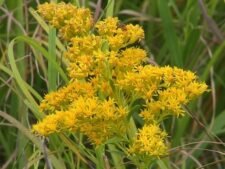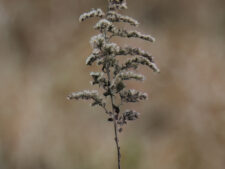
PRAIRIE GOLDENROD
Solidago missouriensis
SUNFLOWER FAMILY (Asteraceae)
 Identification
Identification
- Flowering time - July, August, September
- Uncommon in prairie transplants at NW
- Earliest goldenrod to flower (July)
- Shorter (1-2 feet tall) than our most common goldenrods
- No hairs on the stem
Our earliest flowering goldenrod is a native perennial with an erect, smooth, hairless stem 1-2 feet tall. Narrow, lance-shaped alternate leaves usually have 3 prominent parallel veins. Lower leaves are largest and often shed early with leaves progressively smaller above (A). Branching flower stalks at the top of the stem form a pyramid-shaped nodding flower cluster composed of many small yellow ray and disk florets, each flower only about 1/4 inch across (B). Flowers are attached to just one side of the recurved stalk (secund). Fruit is a tiny seed with an attached cottony plume to facilitate dispersal by the wind.
Occurs in drier upland native prairies where it often forms large colonies. Our earliest flowering goldenrod, it blooms from July to September. It is uncommon at Neale Woods where, to date, it has been found only in small transplanted prairie pieces that were salvaged from local native prairies lost to residential development. These transplants are located at the at the entrance just above the upper parking lot and at the junction of Neale and Wagon Trails.
Separated by its early flowering period and smaller size from Late Goldenrod (Solidago gigantea) and Canada Goldenrod (Solidago canadensis), which have similar pyramidal flower clusters. It is further differentiated from Canada Goldenrod by its smooth, hairless stem. Prairie Goldenrod’s pyramid shaped flower head and narrow leaves are very different from those of another prairie species, Rigid Goldenrod (Solidago rigida), which has leathery, oval leaves and a flat-topped flower cluster.
Another common name is Missouri Goldenrod.
The content of NatureSearch is provided by dedicated volunteer Naturalists of Fontenelle Forest who strive to provide the most accurate information available. Contributors of the images retain their copyrights. The point of contact for this page is: Neal Ratzlaff.


